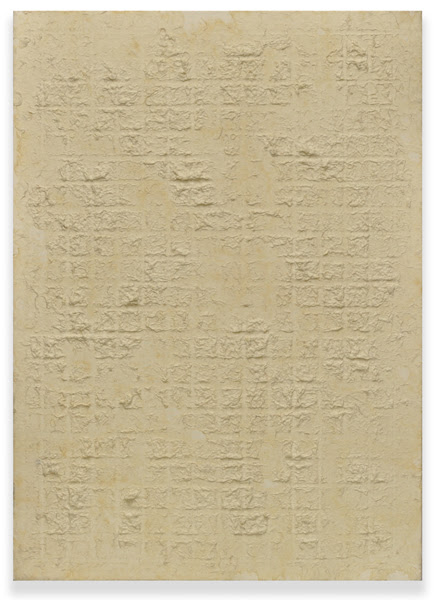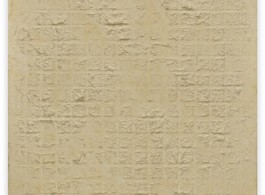Axel Vervoordt Gallery
Antwerp
“Painting without painting, creating without creating, this is what I want.”
Axel Vervoordt Gallery Antwerp is pleased to present its solo exhibition of Chung Chang-Sup (Cheongju, 1927 – Seoul, 2011), a prominent member of the Korean art movement Dansaekhwa*.
After two decades of studying and practicing Western abstract art, more particularly Art Informel, Chung Chang-Sup turned away from the occidental technique of oil painting and started a series that he called Return: a return to his roots, to the affinities and histories of his native Korea. From this point onward he experimented with hanji, a handcrafted fabric that is also called ‘hundred paper’ due to its complex manufacture process of ninety nine steps in order to fabricate one sheet. It is primarily made of tak, the inner bark of the paper mulberry, and it is extremely strong. Historically and culturally, hanji was not only used in painting and calligraphy, but also in architecture, as wallpaper and as panes for windows and even doors.
Chung stated that it was inevitable for him to rediscover hanji: “When I was young, the first thing I saw as soon as waking up in the morning was soft sunlight penetrating through a tak paper window. […] I felt a strong intimacy when reencountering the paper and I was immediately absorbed in experimenting with it for my art.” The core of his interest was the following: “Through the screen of tak paper, one can distinctively sense the wind, light and the flow of time outside his or her room, which allowed us to experience both feelings of being inside and outside. The paper screen reflects the change of time from the outside; when the sun rises, the paper screen is suffused with light, when the sun sets, the light thins away as it would in a black ink painting. This is the realm of creation with no intention of creating.”

Meditation 94734, 1994 (91 x 65 cm)
For the ‘unpainted paintings’ of his series Return, which are reminiscent of windows and doors, Chung applied square or rectangular sheets of hanji on canvases. However, it soon dawned on him that these sheets were still a mere frame, so he decided to dissolve them into pulp, which gave birth to his series Tak throughout the 1980s and paved the way for his latter and final one, Meditation, that extended from the early 1990s to his death in 2011. So for forty years, he worked solely with tak, which he soaked and rubbed in large vats of water, while monitoring the colour degrading from ochre to white. “I scoop up the pulp, spread it on a canvas, tap and knead it, and my conversation with the paper mulberry begins. Abandoning my own will, instead I await its spontaneous response.”
Chung Chang-Sup’s last two series reflect his Taoist belief that an artist balances material and nature in a unified act of making: “In battering and kneading tak, I unknowingly put my breath, odour and finally my soul into the process, thus becoming a part of the process itself.” […] “Adjusting the dampness of tak’s fibre and observing the passage of ‘time’, I experience the ‘planeness’ that can be also felt from the surface of granite or earthenware. I do not want to create an artificial world of intentions on the surface of the material; instead, I am experimenting in a naturalist perspective on art in which my consciousness and the meaning of tak’s materiality would be united.”
Whereas the yellowish hues in his Tak works came solely from the sap of the paper mulberry, Chung introduced other natural pigments in Meditation, mostly brown and black out of tobacco leaves and charcoal. Around the time of this change he wrote: “Recently I began to add colours to tak. Still, this process avoids the artificiality of ‘applying’ colours on the surface. What I pursue is a status in which colours are subtly faded and blurred into yellowish tint or bluish grey in the sediment of time.” In his Meditation works he also introduced geometry, which symbolized the harmony found in nature. At first Chung used a wooden stick or threads to incise the outlines of multiple squares arranged in a grid within the thick tak pulp. Later he focussed on shaping the form of a single large square in the middle of his canvasses.
“Stripping myself of all knowledge and intentions, I bask in liberation. The childhood recollections and the dregs of memories hidden away in the corner of my life are my only encounters. Through tak paper, I wish to meet another ‘me’. My ultimate goal is to depict a world without depiction, a world without creating from the intention of the unintended. As a long truth seeker gets a glimpse of the God, I believe that Oriental spiritualism and Occidental materialism are harmonized on the crossroads of my lonely journey. My paper works, like the surface of old granite immersed in time, indicate an alternative way to rediscover material, time, self and nature through their residues, traces and coincidences.”
*
Dansaekhwa (or Tansaekhwa, depending on which Romanization system is used) is a Korean noun phrase which means ‘single-colour’ painting. It emerged in the late 1960s and began to take root in the early 1970s, but it was never an official movement. There was no consolidated group of artists who worked together toward actualizing a manifesto. The artists to whom this rubric was retroactively attributed by critics like Lee Yil and Nakahara Yusuke, did, however, exhibit in the same shows and even occasionally painted together. What they all had in common was a commitment to thinking more intensively about mark, line, frame, surface, and space and to the process of a physical action that occupied a period of time and took place in a set space.
Despite its literal meaning, Dansaekhwa is very different from most Western monochrome painting, which primarily focusses on the colour itself, taking colour as a physical material and rejecting a varied colour palette for an extremely simplified form. Dansaekhwa looks to a dimension beyond visual abstraction, reinterpreting nature as a reflection of the human mind and returning to nature through creating monochrome planes as the closest feature to nature. Dansaekhwa can be interpreted as a modernized style of the traditional practice in East Asian art that pursues a meditative harmony by blurring the distinction between oneself and nature; the inner and the outer.



